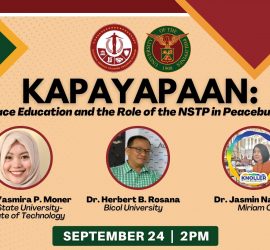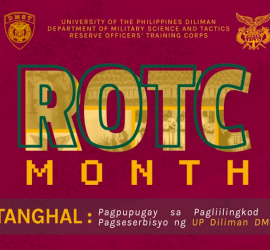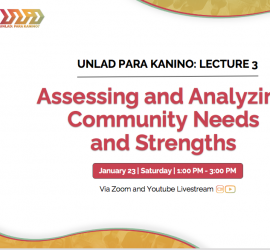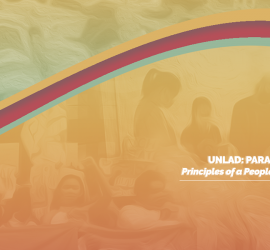In commemoration of the National Peace Consciousness Month held every September, the NSTP Diliman Office organized a webinar entitled “Kapayapaan: Peace Education and the Role of the NSTP in Peacebuilding” last September 24, via Zoom and YouTube Live. The webinar aimed to introduce peace education—what it is and how it is contextualized in Philippine universities—as a new common module topic for NSTP. Together with staunch peace advocates Dr. Jasmin Nario-Galace (Miriam College), Dr. Herbert B. Rosana (Bicol University), and Asst. Prof. Yasmira Moner (Mindanao State University – Iligan Institute of Technology), the webinar explored potential pathways to promote peacebuilding through peace education in Philippine universities and colleges. 480 participants entered the Zoom space, and almost 15,000 viewers were able to watch the engagement through YouTube Live. Bringing together participants from all over the country, the webinar shed light on how peace education is valuable in the peacebuilding process. It opened a wide range of discussion about its implementation: from the provision of training and support for teachers despite not being peace educators, to the challenge of possible peacebuilding projects during this remote and blended learning period. Dr. Ma. Theresa Payongayong, Vice Chancellor for the Academic Affairs of the University of the Philippines Diliman, formally opened the event welcoming the speakers and the thousands of faculty and students representing various state universities and colleges (SUCs) in the country. She shared that UP Diliman, consistent with UP’s mandate to become a public service university, has provided supplementary knowledge products and instructional materials for various academic programs. As she had said, “For the past 18 months of adapting and adjusting to the new normal, peace is very much needed… and we are very much looking forward to ‘Healing as One Nation and Recovering as a Better Generation,’ as the theme for this year’s National Peace Consciousness Month.” NSTP Diliman Office Director Asst. Prof. Dennis Quilala framed the peace education within the NSTP while underscoring the importance of teaching peace within the university. Setting the agenda for the webinar, Asst. Prof. Quilala also provided an overview of the Tatak UPD NSTP Common Module Topics […]
Yearly Archives: 2021
As the UP Diliman Department of Military Science and Tactics (DMST) nears its centennial year, its own Reserve Officers’ Training Corps (UP Diliman ROTC) has lined up a host of online events to celebrate ROTC Month amidst the pandemic. “2020 has been a trying time for all of us. A challenging semester of abruptly shifting to online learning has left us with no choice but to improvise, adapt and overcome,” said Colonel Jaime R. Datuin, the Commandant and Department Head of DMST, in his speech during the March 01, 2021 Virtual Flag Raising Ceremony of UP Diliman. “As UP DMST nears its centennial year, this year’s ROTC Month will kick off the celebration.” While the university-based military instruction began in the country and in the University of the Philippines in 1912, the first official ROTC unit was born when UP DMST was established in 1922. Later, in 2012, former President Benigno S. Aquino III signed Proclamation No. 340 declaring that the celebration of the ROTC Month shall be observed annually during the month of March. Thus, this March 2021, UP Diliman ROTC celebrates ROTC Month with the theme “TANGHAL: Pagpupugay sa paglilingkod at pagseserbisyo ng UP Diliman DMST.” As a tribute to UP DMST’s upcoming one hundred years of commitment and service to the country, the Corps has put together a month-long series of various contests and activities using virtual platforms, such as the online Physical Fitness Test Challenge, Digital Art Contest, Webinar, and feature posts from the Vanguard Hall of Fame. Though featuring UPROTC, the celebration is not limited to ROTC cadets or even UP students. The feature posts from the Vanguard Hall of Fame are public and the webinar with the theme “‘SIYASAT: Breaking Down Gender Roles in the Philippine Army” as well as the Digital Art Contest with the theme “ALAY: Mahigit isang siglo ng hindi matatawarang paglilingkod ng mga kadeteng Pilipino” are both open to participants in and out of any NSTP component or university in the country. The webinar will be held on March 27, 2021 from 9:00AM to 11:00AM and will feature Lieutenant Colonel […]
The final webinar of the series, UNLAD: Para kanino? Talakayan ukol sa pagbubuo ng mga proyektong pang-kaunlaran ng komunidad, explored the fundamentals of Preparing and Writing Project Proposals. The session’s speaker was Assistant Professor Devralin T. Lagos from the College of Social Work and Community Development, University of the Philippines Diliman. Just like with the previous sessions, this webinar is aimed at ensuring that all processes involved from the conceptualization until evaluation of projects in the community are anchored upon the principles of a people-centered development. It emphasized the importance of community organizing. Project development practitioners need to conduct iterative and joint writing workshops and to assign community workers as “facilitators of development planning and proposal development” that “handover the stick” to the community. The speaker reiterated that the people in the communities are not just “add-ons.” They should be the centre of the project. To be anchored in the principles of people-centred development means to undertake the questions “Kaninong plano at pangarap ang dapat maisalamin ng project proposal?” and “Sino ang dapat magsulat ng proposal?” With conviction, the speaker answered that her bias was that the community members should be writing the proposal. In the latter part of her presentation, she cited an example where a community wrote a paper abstract and even presented it at an international conference proving her point that community members can write a project proposal. However, she acknowledged the prevalence of instances where the office or the students themselves write the proposal. Most importantly, she reminded everyone that it is still possible to engage in participatory methods when writing proposals. The speaker cited an example that reinforced the mentioned key points. A fisherfolk community harvests and sells shellfish. This community is prone to red tide, resulting in loss of income and extreme hunger and poverty. The community had done community planning workshops concerning their situation due to the red tide. They analyzed their progression of vulnerability and progression of safety. They realized that their lack of savings even without red tide causes extreme poverty. Poverty is the lack of access to resources of the […]
As the webinar series continued on its fourth run, its focus now shifted to Development, Implementation, and Evaluation of Participatory Projects. The first speaker for this webinar, Sir Karl Arvin Hapal from the Department of Community Development, College of Social Work and Development at the University of the Philippines Diliman, explained that the concepts he will be discussing are based on the concept of decolonization of development. As he said, this means that the development is being brought back to the people. Prof Hapal’s first key point is about the conventional practices and methods that are used for participatory project development, implementation, monitoring, and evaluation. These include Logical Framework, Theory of Change, and SWOT Analysis. A logical framework is used to assess the contribution of small activities to the bigger objective. Theory of Change includes if-and-then-statements (if C is done, E will be the result) to assess a project. SWOT Analysis involves looking into the strengths, weaknesses, opportunities, and threats of a project. Prof Hapal claimed these methods as logic and evidence-based but he also claimed that these are not without limitations. He expounded by saying that these methods have philosophical biases. It was developed through the lenses of business and public administration – through managers and administrators. Due to their origin, these methods were subjected to top-down tendencies. Moreover, the conventional methods perceive a project life cycle like that of a tree. It is linear. Prof. Hapal contradicted this and said that a project life cycle is, in reality, not linear. He challenged the participants to reexamine the planning, implementation, and evaluation of projects to make them aligned with the principles of people-centred development. By sharing an example based on his experience, Prof Hapal discussed how the reexamination is done. He mentioned the social enterprise of Maigting na Samahan ng Panlipunang Negosyante or Igting from Towerville, a relocation site in San Jose Del Monte Bulacan. There are three key points on how Igting was able to sustain its social enterprise. First was the “plano vs kolektibong pangarap at shared values.” This indicates that Igting focused more on affirming their […]
The third of the five webinars for the series UNLAD: Para kanino? Talakayan ukol sa pagbubuo ng mga proyektong pang-kaunlaran ng komunidad, which was held through the Zoom platform and YouTube live reached more than ninety (90) participants. This webinar revolved around the topic of assessment and analysis of the needs and strengths of the community. Asst. Prof. Paul Edward Muego from the College of Social Welfare and Community Development started the discussion by emphasizing that, “mahalaga pag pinag-uusapan natin [ang] assessment at analysis of community needs and strengths ay dapat nakatuon ito sa pagkamit ng mga pangkalahatan at partikular na layunin ng people-centred development.” According to him, these objectives include promoting the welfare and well-being of the people, capacity building, strengthening communities’ participation in various organization efforts, promoting learning, increasing self-efficacy and confidence in self and community efforts, and lastly, assessment and analysis of needs and strengths should encourage fellowship. Assessing and analysing the needs and strengths of communities should not be disintegrated with the concept of community organizing, Prof Muego pointed out. Through community organizing, the organizers can collect data and information about the community which will reveal the needs and strengths of the community. He further highlighted that the organizers should only assist the people in doing such instead of imposing instructions to the community. He then proceeded in outlining the processes involved in participatory project development and management and made the participants know where assessment and analysis of needs and strengths come into play. He mentioned that knowledge of the needs and strengths of the community will aid in identifying which projects are feasible and should be implemented. Why do people need to play a major role in the assessment and analysis of needs and strengths? Sir Muego answered this by saying that it is to make sure that the needs and strengths came from the community itself. This will verify the identified needs and strengths because they came first hand from the people. Moreover, if the assessment and analysis are done by the community, their understanding of their lives and their situation will deepen and […]
UNLAD: Para kanino? Talakayan ukol sa pagbubuo ng mga proyektong pang-kaunlaran ng komunidad continues its run, as it featured the topic Steps and Methods in Community Organizing on January 16, 2020. It was attended by ninety-five (95) participants. While the first webinar circulated around people-centred development this session shifted its focus on community organizing. The first speaker in this webinar is Professor Victor Obedicen. Professor Obedicen teaches both undergraduate and graduate students in various courses such as Community Organizing, Community Planning, and Community-based Disaster Risk and Reduction Management in the College of Social Work and Community Development at the University of the Philippines Diliman. The resource person reminded everyone that community organizing can take several forms and that it can come from different points of view. Moreover, the speaker clarified that the discussions will focus on his institution’s point of view. Community organizing is not just forming mere organizations rather is the formation of organizations of the people. The center of community organizing is the people. It is a process that strengthens the capabilities and skills of people in the community to identify, face, and solve their problems. Since it revolves around people, one of the goals of community organizing is ensuring that people are aware of their situation and their potentials and resources to achieve a better quality of life. Community organizing aims to develop mechanisms and structures for upholding and protecting people’s rights. These awareness and mechanisms must reflect on actions that will contribute to changing the community. The speaker continued by explaining why organizing and organizations are important. The unity of people creates power and strength. Organizations mean more people are addressing and thinking about solutions for the problems. They also have mechanisms for advocacy and networking. Another importance of organizing is that organizations, when functional and strong, tend to last longer. Lastly, they serve as a vessel in accomplishing project development plans for the community. Prof. Victor mentioned that in community organizing there are non-negotiables or ideas and principles that are not up for debate but rather accepted as truth. These include (1) trusting the people, […]
On Monday, January 11, 2020, the webinar series UNLAD: Para kanino? Talakayan ukol sa pagbubuo ng mga proyektong pang-kaunlaran ng komunidad was officially launched. It was spearheaded by the first webinar of the series, Principles of a People-Centred Development. The webinar was attended by more than a hundred participants. It was welcomed by the NSTP Director Sir Dennis Quilala. He reminded everyone to uphold the query asking for whom the development is. He emphasized the importance of maintaining critical lenses and programs to implement. Moderated by Sir Giovanni Francis Legaspi, the webinar revolved around social issues and stressed the importance of people-centred development in addressing these issues. The first speaker, Professor Venarica Papa, is an Assistant Professor in the College of Social Work and Community Development. Professor Vena’s research interests include human and people’s rights, community governance, and alternative development. She started by defining what poverty and development means. Poverty was perceived by some as a product of destiny or luck. Some say that poverty was a result of idleness or just because one is a failure. The participants were reoriented that this way of thinking disregards the existence of structural barriers that hinders one to attain development, regardless of their determination, skills, and perseverance. This also forces the poor to accept their condition because it is what it is. Development was defined as a desirable state that was intentionally strived for. It is not something that one passively waits for. It was also emphasized that in development, questions as “What [is it]”, “Why [it was done]”, “How [it was done]”, “[it was done] By whom]” and “For whom [it was done]” are crucial questions to consider in formulating development projects. Professor Vena then proceeded to discuss what people-centred development means. People-centred development is the development “of the people, for the people, and by the people”. It highlights that development happens when people realize their condition and their capability to take part in making decisions that concern them. It is when groups of people who recognize and accept their right and responsibility to make decisions and act upon their own […]






